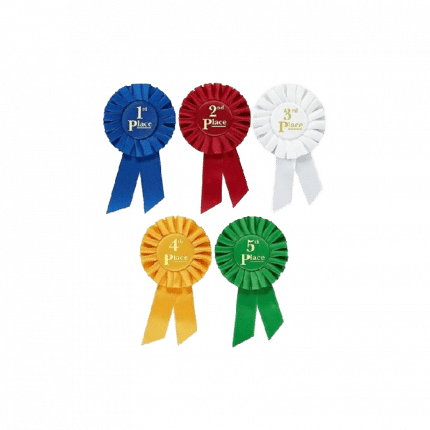The meaningful colors of award ribbons!

The meaningful colors of award ribbons! – Clinch Star
The Meaning Behind Award Ribbon Colors: What They Symbolize
Award ribbons come in all shapes and sizes, but they all have color in common. Ribbon colors vary by celebration and achievement, but some carry universal prestige and symbolism. In this article, we’ll explore the meanings behind the colors of award ribbons to help you understand each color’s significance. From placement rankings to honorary distinctions, each color tells its victory and the story of recognition and achievement.
In this article, we’ll explore the meaning behind the colors of award ribbons—from 1st place to participation—and how they represent emotion, symbolism, and accomplishment.
📜 A Brief History of Award Ribbons
Award ribbons have been part of human culture for centuries. They date back to the 16th century, when royalty and military officers used them to signify elite, rank, or honor. Over time, ribbons became associated with merit and excellence in civilian life, from horse shows and science fairs to corporate awards and international sporting events.
Color Symbolism Across Cultures
While blue signifies trust and excellence in Western cultures, it can symbolize mourning and pain in parts of the Middle East. In China, red represents luck and joy, while in South Africa, red can signify mourning. Understanding cultural interpretations can be crucial when selecting ribbon colors for international events or diverse audiences. So, we would like to let you know that this article and its symbology are for the American Champion.
Common Ribbon Colors and Their Meanings
Blue
Blue is often associated with loyalty, trust, and dependability. Like the color of the sky and ocean, both vast and seemingly endless, blue evokes a sense of stability and calm. It is frequently used in national flags to symbolize patriotism and unity and is a top choice for military and academic awards. Blue also represents intelligence and truth, often used for champions and first-place honors. It is usually given to the winner or the best at….
Green
Green represents nature, growth, and renewal. It’s also associated with money and success, making it a common choice for finance- or business-related recognition. Green is frequently used for environmental awards, graduations, and honors celebrating new beginnings or progress. It symbolizes life and transformation.
Gold
Gold has long been associated with royalty, wealth, and achievement. As the color of the highest Olympic medal, it symbolizes excellence, outstanding, and first-rate accomplishment. When awarded, gold signifies the highest level of recognition.
Purple
Purple symbolizes nobility, leadership, and wisdom. Historically linked to royalty, it’s a popular choice for service or leadership awards. It also expresses creativity and imagination, fitting for artistic or academic honors.
Red
Red evokes passion, energy, and strength. It’s a standard color for sports-related awards due to its associations with courage, determination, and competitiveness. While red can also symbolize danger or anger. A red ribbon is alos a symbol of excitement and prestige when used correctly in awards.
Yellow
Yellow is the color of joy, optimism, and celebration. It’s often awarded for achievements that deserve recognition in a cheerful or uplifting context, symbolizing brightness and positivity.
White
White represents purity, peace, and neutrality. It’s often used in awards related to intelligence, fairness, or commemorative events. White also symbolizes new beginnings and sincerity.
Light Blue
Light blue is calming and associated with the sky and sea, much like dark blue, but with a softer tone. It symbolizes trust, loyalty, and justice, making it ideal for awards recognizing team efforts, long-term service, or honorable conduct.
Dark Blue
Dark blue conveys authority, power, and discipline. It’s often used for leadership or bravery awards and is fitting for recipients who’ve demonstrated exceptional commitment, integrity, or excellence in their field.
Pink
Pink is often linked with compassion, care, and femininity. It symbolizes love, kindness, and hope, which is why it’s widely used as an awareness ribbon, such as for prostate cancer or breast cancer awareness. It’s a meaningful color for volunteer or charity awards.
Placement Colors: 1st to 6th Place
The order and color of ribbon placements also carry symbolic meaning:
1st Place—Dark Blue: Dark blue symbolizes power, intelligence, and trust, and it is a strong and dignified color used for top honors.
2nd Place – Red: Red stands for passion and determination. While it falls short of first place, it’s still a premium and prestigious achievement.
3rd Place – White: White conveys peace and contentment, representing a commendable accomplishment that almost reached the top.
4th Place – Yellow: Cheerful and optimistic, yellow reflects the energy and spirit of someone who came close and deserves encouragement.
5th Place—Green: Associated with growth and renewal, green signifies effort and potential, even if it is not among the top winners.
6th Place – Pink: Pink denotes kindness and value. Though not a top contender, it still honors participation and heart.
Special Awards, Honorable Mentions, and Participation Ribbons
Special Awards – Purple: Combining the power of red and the calm of blue, purple represents creativity, royalty, and distinguished merit.
Honorable Mention – Orange: A vibrant color symbolizing creativity, enthusiasm, and encouragement.
Participation—White and Light Blue: These colors reflect sincerity, peace, and new beginnings, honoring everyone who participated.
Fun Fact Box
Did You Know?
The phrase “blue ribbon” is often used to refer to something of the highest quality, such as “a blue ribbon panel of experts” or “blue ribbon school,” thanks to the long-standing tradition of blue as the top award color for a competition or a prize.
Final Thoughts
Award ribbons have been a part of human culture for centuries, and the colors behind them are rich with meaning. The next time you see a ribbon, take a moment to reflect on what its color might symbolize—not just to the giver, but to the recipient as well. You might be surprised at what you discover!





